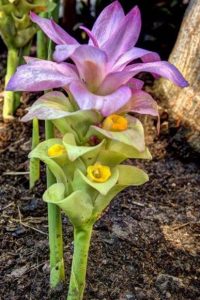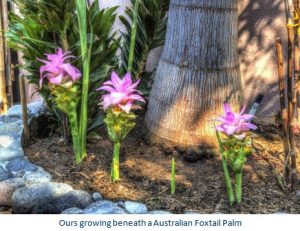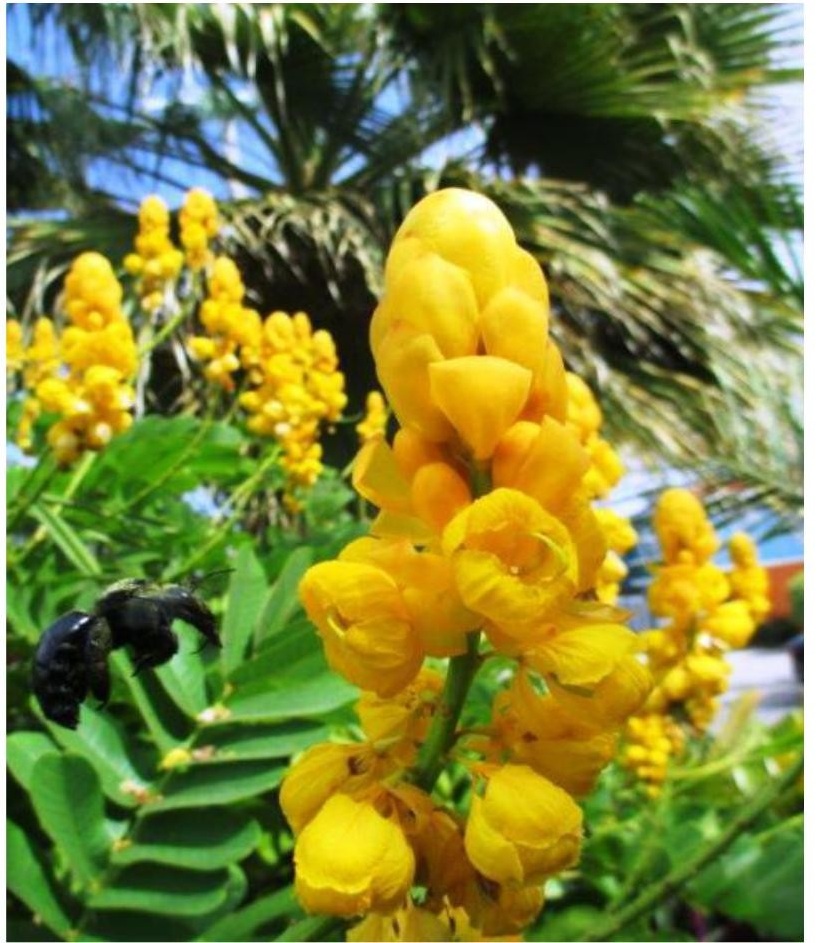By Tommy Clarkson from the October 2016 Edition
Java Turmeric, Curcuma xanthorrhiza
Family: Zingiberaceae
Also known as: Indian Saffron or Hidden Lilies
In that I had forgotten where and how I had gotten these absolutely gorgeous flowering plants, I was wholly  stumped as to the name of these. Thus, I sought the sagacious counsel of Anders Lindstrom, the savviest botanical guy I know. In addition to being the world’s foremost authority on cycads (to see his collection is a truly awesome experience) he is the curator of the spectacular “I kid you not” 600 hectares (1,483 acres or nearly three square miles) Nongnooch Tropical Gardens outside of Pattaya in Thailand.
stumped as to the name of these. Thus, I sought the sagacious counsel of Anders Lindstrom, the savviest botanical guy I know. In addition to being the world’s foremost authority on cycads (to see his collection is a truly awesome experience) he is the curator of the spectacular “I kid you not” 600 hectares (1,483 acres or nearly three square miles) Nongnooch Tropical Gardens outside of Pattaya in Thailand.
He promptly identified these stunners as members of the Curcuma genus quite probably Curcuma xanthorrhiza members of the ginger family. Aware that Patty and I had taken a week-long cooking course when last in his corner of the world, he reminded me that its edible roots can be used in preparation of Thai cuisine.
They are sometimes referred to as Hidden Lilies in that their inflorescences are partially tucked away from view among the leaves. There are around forty different species of these deciduous rhizomatous coming from Southeastern Asia, In-dia and Malaysia. (Point of interest: In Hawaiian, all of these are called Olena. This has led some gardeners to refer to the entire array of different plants as Cucuma olena. This, how-ever, is not a recognized botanical name.)
 Many of the Costus species are suitable for growing in pots or planters, thriving outdoors in moist and humid environs.
Many of the Costus species are suitable for growing in pots or planters, thriving outdoors in moist and humid environs.
As they die back to the soil surface level in the cooler times, mulching is probably a good idea. But remember to mark them well as if you are like me you may well forget what is where and inadvertently plant another specimen atop them during their seasonal slumber!
Java Turmeric like sandy loam with peat or fine coconut fiber (coir) added. But do not water them while they are dormant, commencing regular watering only once the sprouts arise. As Anders told me “Remember that these plants go dormant in the dry season and need a dry rest, but they will be up, flowering and growing well in the spring with the first rain. “
Usually with long petioles, their leaves are basal (arising from a rhizome, root, bulb or corm). The large rhizome (a prostrate stem running along or just below the ground surface) is that which contains the herbal qualities. Kirsten Albrecht Llamas, in her excellent book Tropical Flowering Plants states, “The flower spikes are on individual scapes (leafless stalks arising directly from a rhizome, bearing a flower or inflorescence) or on the leafy stem. The fertile flowers are in usually shorter, less colorful scoop-shaped bracts at the base of the inflorescence with an ornamental coma (a whorl of sterile bracts at the top).”
Its uses include incorporation as a mild spice used in drinks providing both flavor and a yellowish color as  well as incorporation in seasoning food such as in the curry of India. By itself, it has an aromatic, pungent odor and a bitter taste.
well as incorporation in seasoning food such as in the curry of India. By itself, it has an aromatic, pungent odor and a bitter taste.
Research bears out that the rhizome can be used medicinally. Among its positive benefits is that it has liver protection properties. Additionally I’ve read that, it is “anti -oxidant and antiedemic (and can) encourage bile and prevent the formation of gallstones”. Reading further, I noted that its “rhizomes have anti -viral and anti-inflammation properties”.
But its array of positives, purportedly, doesn’t stop there in that its ability to inhibit bacterial growth lead it to be employed against acne; It can normalize digestion; Increase breast milk production; Decrease cholesterol levels; Be used in the treatment of inflammatory bowel disease; And, can be effective for long-term maintenance therapy of ulcerative colitis and urinary tract infection.
There are a plethora of scholarly articles, research project results and scientific articles to be found on Curcuma xanthorrhiza. In fact, while apparently gaining in recognition and popularity, little seems to be written in easily-found botanical books about the care, upkeep and maintenance of growing any of the Curcumas.
Even Llamas while writing about twelve of the Curcuma species neglected to discuss the C. xanthorrhiza. But in perusal of her publication I noted that the C. australasica and C. phaecaulis looked quite similar to my plants.
However, those with whom I spoke and corresponded indicated that there is a growing awareness of the beauty of these plants.
Accordingly, more information should be coming “on-line” soon!
Download the full edition or view it online
—
Tommy Clarkson is a bit of a renaissance man. He’s lived and worked in locales as disparate as the 1.2 square mile island of Kwajalein to war-torn Iraq, from aboard he and Patty’s boat berthed out of Sea Bright, NJ to Thailand, Germany, Hawaii and Viet Nam; He’s taught classes and courses on creative writing and mass communications from the elementary grades to graduate level; He’s spoken to a wide array of meetings, conferences and assemblages on topics as varied as Buddhism, strategic marketing and tropical plants; In the latter category he and Patty’s recently book, “The Civilized Jungle” – written for the lay gardener – has been heralded as “the best tropical plant book in the last ten years”; And, according to Trip Advisor, their spectacular tropical creation – Ola Brisa Gardens – is the “Number One Tour destination in Manzanillo”.




